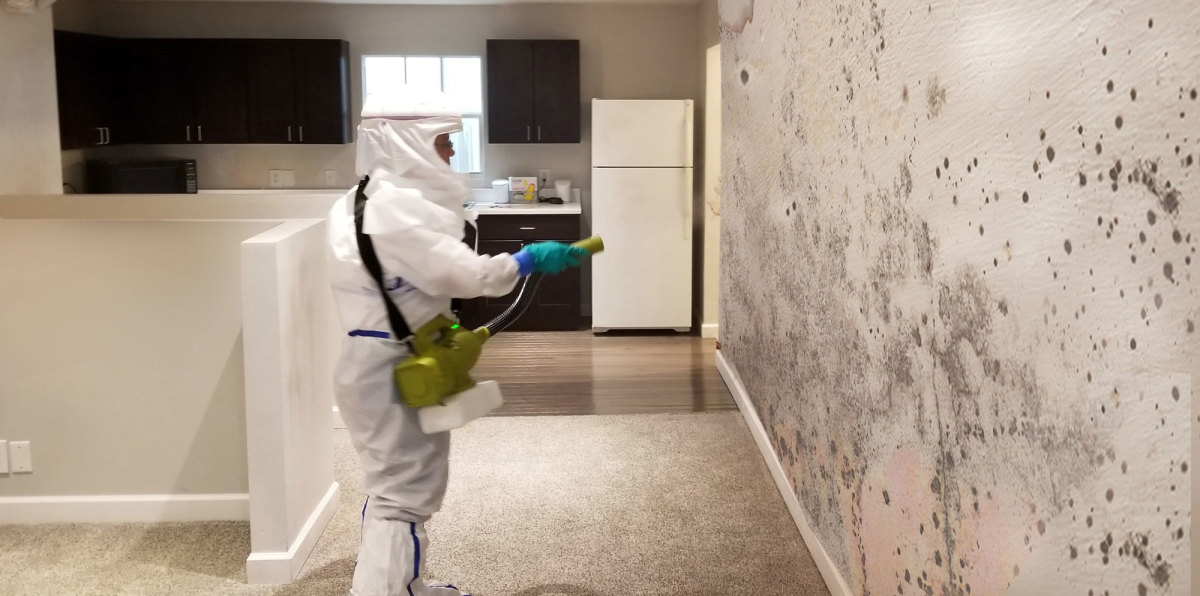1. Florida

It’s no surprise that Florida tops the list of states with the worst mold problems. The state’s warm, humid climate creates the perfect environment for mold to flourish, especially in areas hit by frequent tropical storms and hurricanes. Flooding and high humidity levels contribute to mold growth in homes, especially in basements and poorly ventilated areas. Floridians should take extra precautions, such as using dehumidifiers and ensuring proper ventilation, to prevent mold infestations.
To learn more about protecting your home from humidity and mold, check out this guide from Energy.gov.
2. Texas

Texas faces a variety of weather conditions that make it a hotspot for mold growth, especially in the Gulf Coast region. The combination of high humidity, heavy rainfall, and occasional flooding from hurricanes creates prime conditions for mold. Basements, crawl spaces, and attics are particularly vulnerable. Homeowners in Texas should be vigilant about moisture control and perform regular inspections to prevent mold from spreading.
3. Louisiana
Louisiana, known for its swamps and high humidity, experiences frequent hurricanes and flooding, which can lead to mold problems. The aftermath of Hurricane Katrina, for example, left many homes and businesses with severe mold infestations. In a state where moisture levels remain high year-round, homeowners should focus on moisture management and proper ventilation to reduce the risk of mold growth.
For more information on mold prevention after flooding, visit the CDC’s mold resource page.
4. California
While California may not have the same level of humidity as some other states, its frequent wildfires create a different type of mold issue. Homes damaged by fires are often vulnerable to water damage from firefighting efforts, which can lead to mold growth. In addition, areas of California with high humidity and coastal environments, such as the Bay Area and Southern California, are prone to mold problems in basements and attics. Homeowners should monitor for mold after any type of water damage and address it quickly to prevent long-term issues.
5. New York

New York is another state where weather extremes contribute to mold problems. From humid summers to heavy snowfall in the winter, New York homes often experience water damage that can lead to mold growth. Flooding from heavy rainstorms and melting snow can create ideal conditions for mold in basements and crawl spaces. In addition, older homes with poor insulation and ventilation are especially vulnerable to mold infestations.
6. Mississippi
Mississippi’s hot, humid climate, combined with frequent flooding from hurricanes, makes it one of the top states for mold issues. Mold tends to grow rapidly in homes that experience water damage, and with the state’s high year-round humidity, even small leaks or damp areas can become breeding grounds for mold. Homeowners should be proactive about inspecting their homes for mold, especially after storms or heavy rainfall.
7. South Carolina
South Carolina is known for its coastal environment, high humidity, and frequent hurricanes. The combination of moisture, warm temperatures, and flooding creates a perfect environment for mold growth in homes. Attics, basements, and bathrooms are common places where mold can develop, particularly in areas with poor ventilation. Regular inspections and moisture control measures are key to preventing mold in South Carolina homes.
8. Georgia

Georgia’s warm, humid climate and frequent summer thunderstorms make it another state with significant mold problems. Like many Southern states, Georgia experiences high levels of humidity year-round, which contributes to the spread of mold in homes, especially in areas that are not well-ventilated. Homeowners should invest in dehumidifiers and ensure that air circulates properly throughout the house to reduce the risk of mold growth.
9. North Carolina
North Carolina’s mold issues stem from its humid climate, frequent hurricanes, and heavy rainfall. Flooding from storms can lead to water damage in homes, creating the ideal environment for mold. Basements, crawl spaces, and attics are especially prone to mold growth, and homeowners should be diligent about moisture control and regular inspections to prevent mold from spreading. For more tips on moisture control in humid environments, visit HGTV’s dehumidifier guide.
10. Alabama
Alabama rounds out the top 10 states with the worst mold problems due to its high humidity and frequent storms. Like other Southern states, Alabama experiences long, hot summers with high moisture levels, which can cause mold to grow in homes that aren’t properly ventilated. Flooding from hurricanes and heavy rainstorms can also contribute to mold infestations in basements and crawl spaces. Regular cleaning, moisture management, and dehumidifiers can help keep mold at bay.
How to Protect Your Home from Mold, No Matter Where You Live

While the above states are especially prone to mold problems, mold can grow anywhere if the conditions are right. Whether you live in a humid climate or experience occasional flooding, there are steps you can take to protect your home from mold:
1. Control Humidity Levels
Mold thrives in humid environments, so it’s important to keep indoor humidity levels below 50%. Use dehumidifiers in areas like basements, bathrooms, and attics to reduce moisture and prevent mold growth. Learn more about how to manage indoor humidity with this dehumidifier guide from Consumer Reports.
2. Fix Water Leaks Promptly
Water leaks from pipes, roofs, or appliances can lead to mold growth if not addressed quickly. Inspect your home regularly for signs of leaks or water damage and repair them as soon as possible to prevent moisture from creating the perfect environment for mold.
3. Improve Ventilation
Good airflow helps reduce moisture buildup, especially in high-humidity areas like bathrooms, kitchens, and basements. Use exhaust fans, open windows, and install proper ventilation systems to keep air moving and moisture levels low.
4. Dry Wet Areas Immediately
If your home experiences flooding or water damage, it’s critical to dry the affected areas as quickly as possible. Mold can start to grow within 24-48 hours in damp environments, so use fans, dehumidifiers, and wet/dry vacuums to dry out waterlogged areas.
5. Regular Mold Inspections
Schedule regular inspections of your home, especially if you live in a state prone to mold growth. Professional mold inspectors can identify areas of concern and help you address moisture issues before they turn into major mold problems. Citywide Mold Mitigation offers expert mold inspection and removal services to keep your home mold-free.
When to Call Citywide Mold Mitigation for Help
If you’ve discovered mold in your home or suspect mold growth, it’s important to act quickly to prevent further damage. Mold can spread rapidly and pose serious health risks to you and your family. Citywide Mold Mitigation offers professional mold remediation services to identify and remove mold from your home, no matter how severe the infestation. Contact us today to schedule a consultation and protect your home from the dangers of mold.
FAQ
| Question | Answer |
|---|---|
| Why is mold more common in certain states? | Mold is more common in states with high humidity, frequent rainfall, and flooding. These conditions provide the moisture needed for mold spores to grow and spread, especially in poorly ventilated areas. |
| How can I prevent mold in my home? | To prevent mold, control indoor humidity levels, fix water leaks promptly, improve ventilation, and dry wet areas immediately. Regular inspections and proper moisture management are key to keeping mold at bay. |
| What are the health risks of mold exposure? | Mold exposure can cause respiratory issues, allergic reactions, asthma attacks, and other health problems, particularly for people with weakened immune systems or preexisting conditions. It’s important to remove mold as soon as it’s detected. |
| What should I do if I find mold in my home? | If you find mold in your home, clean small areas with a mold remover or natural solution like white vinegar. For larger mold infestations, it’s best to call a professional like Citywide Mold Mitigation for safe and effective mold removal. |
| When should I call a professional for mold removal? | Call a professional if mold covers a large area, if it keeps returning after cleaning, or if it has caused significant damage to your home. Professional mold remediation services can ensure the mold is completely removed and prevent it from coming back. |
If you live in one of the states listed above or are dealing with mold issues in your home, contact Citywide Mold Mitigation for expert mold removal and prevention services today.

